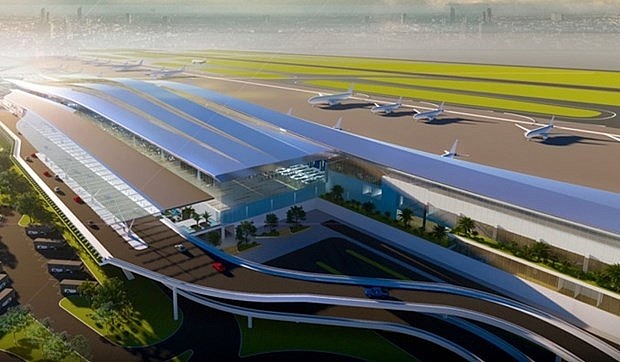Design of Tan Son Nhat airport’s new terminal inspired by ‘Ao dai’
 |
| Design of Terminal T3 inspired by the image of ‘Ao dai’ (Photo: ACV) |
Hanoi – The design inspired by the image of ‘Ao dai’ (Vietnamese traditional long gown) – one of the country’s cultural symbols - has been selected for Terminal T3 of Ho Chi Minh City's Tan Son Nhat International Airport.
The Airports Corporation of Vietnam (ACV) – the investor of the project – has recently completed and approved the design of the terminal, and organised bidding to select contractors so as to start construction in the third quarter of this year.
According to the investor, Terminal T3 will have a soft curved roof stretching from the terminal to the garden at the centre of the commercial-office complex, reminiscent of the flap of the Vietnamese ‘Ao dai’.
Recently, Prime Minister Pham Minh Chinh ordered construction of Terminal T3 be started in the third quarter of 2022 and the facility be put into use in September 2024.
PM Chinh also asked the Ministry of National Defence to work with relevant parties to hand over 16.05ha of land under its management for the terminal project and another 11.89ha for the building of a road linking nearby Tran Quoc Hoan and Cong Hoa roads in Tan Binh district in July.
The T3 terminal project was approved by the Government in 2020 at a cost of 10.99 trillion VND (470.5 million USD), using the Airports Corporation of Vietnam (ACV)’s budget. Construction is expected to take 37 months.
Once operational, it will be able to serve up to 20 million passengers annually, according to the Prime Minister’s Decision 657/QD-TTg, dated May 19, 2020, that gave the green light to the project.
The new facility will handle domestic flights, thus helping to ease pressure on T1 that is currently overloaded and to improve service quality.
What the stars mean:
★ Poor ★ ★ Promising ★★★ Good ★★★★ Very good ★★★★★ Exceptional
Related Contents
Latest News
More News
- Protect what’s next: towards a future free from meningococcal group B disease (December 05, 2025 | 18:00)
- New ILO report offers policy recommendations for disability inclusion (December 04, 2025 | 15:18)
- Maternal job loss may affect children’s mental health, research shows (December 03, 2025 | 19:11)
- Women lead Vietnam’s shift to climate-resilient agriculture (December 03, 2025 | 19:10)
- Experts highlight unpaid care work as key barrier to gender equality (December 03, 2025 | 15:15)
- Opportunities and inequalities for women workers in Vietnam's garment industry (December 03, 2025 | 09:00)
- Vietjet flights carry love to devastated central region (November 28, 2025 | 11:35)
- New initiative to boost the fight against domestic violence (November 26, 2025 | 10:00)
- South Korea funds IOM relief for Vietnam’s typhoon-affected communities (November 24, 2025 | 15:33)
- AI and human-centred values set to shape the future of HR in Vietnam (November 21, 2025 | 18:04)

 Tag:
Tag:





















 Mobile Version
Mobile Version